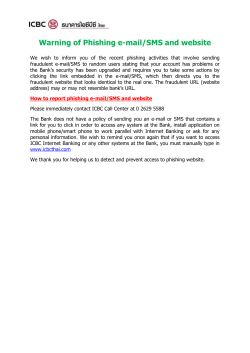
poster - University of Alabama at Birmingham
UDaaS: A Cloud-based URL-Deduplication-as-a-Service for Big Datasets
Shams Zawoad, Ragib Hasan, Gary Warner, and Anthony Skjellum*
{zawoad, ragib, gar}@cis.uab.edu, skjellum@auburn.edu
Department of Computer & Information Sciences, University of Alabama at Birmingham, USA
*Department of Computer Science and Software Engineering, Auburn University, USA
Motivations
• Duplicate URLs introduce waste of
computing and storage resources.
• The number of potential malicious URLs are
too many to deduplicate using local
resources.
UDaaS Operation
Queue Manager
Create EC2
Instances
Create SQS
Queues
VM
VM
• Leveraging the elastic nature of the cloud, we
can deploy a highly scalable, parallel URL
deduplication infrastructure.
VM
Assign Queues to
Instances
Instance Manager
Push URL Source
Unique Website
Repository
Features
• Instance Manager: Create, start , and stop
instances, assign queues, view and clear logs,
and change configurations.
• Queue Manager: Create, clear, and remove
queues.
Applications
• UDaaS can increase a URL analyst’s productivity
by providing only unique content.
• Can improve the performance of phishing and
other counterfeit websites detection rate.
Contribution
• We presented UDaaS, which can be used in
academia and industry to easily deploy a highly
scalable and distributed cloud-based
infrastructure to deduplicate a big URL dataset.
… ….
UDaaS Architecture
Website
Fetcher
Queue
Fetcher
Queue
Listener
References
Thread
Thread
Uploader
Queue
… ….
Website
Uploader
Queue
Listener
Thread
Thread
Central
Website
Repository
[1] E. Ferguson, J. Weber, and R. Hasan, “Cloud based content fetching: Using cloud
infrastructure to obfuscate phishing scam analysis,” in IEEE SERVICES,2012, pp. 255–261.
[2] S. Zawoad, R. Hasan, M. M. Haque, and G. Warner, “CURLA: Cloud-based spam url analyzer
for very large datasets,” in IEEE Cloud, 2014.
[3] B. Wardman, T. Stallings, G. Warner, and A. Skjellum, “High-performance content-based
phishing attack detection,” in eCrime Researchers Summit, 2011. IEEE, 2011, pp. 1–9.
[4] C. Whittaker, B. Ryner, and M. Nazif, “Large-scale automatic classification of phishing
pages” in NDSS, 2010.
[5] Y. Zhang, J. I. Hong, and L. F. Cranor, “Cantina: a content-based approach to detecting
phishing web sites,” in WWW 2007. ACM, 2007, pp. 639–648.
© Copyright 2025










